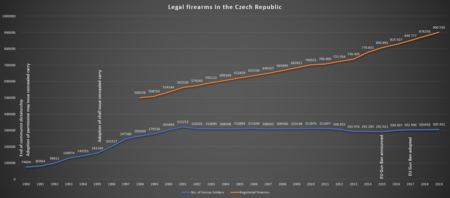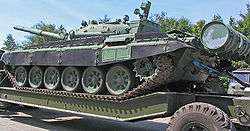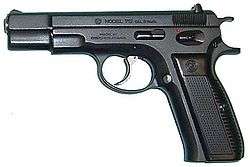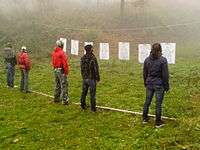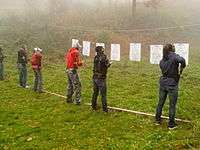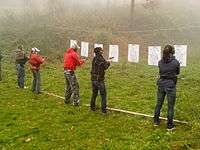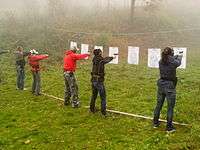Gun law in the Czech Republic
Gun laws in the Czech Republic in many respects differ from those in other Member states of the European Union (see Gun laws in the European Union). A gun in the Czech Republic is available to anybody subject to acquiring a shall issue firearms license. Gun licenses may be obtained in a way similar to a driving license – by passing a gun proficiency exam, medical examination and having a clean criminal record. Unlike in most other European countries, the Czech gun legislation also permits a citizen to carry a concealed weapon for self-defense – 248,278 out of 305,452 legal gun owners have a concealed carry permit (31 Dec 2019).[4] The vast majority of Czech gun owners possess their firearms for protection, with hunting and sport shooting being less common.[5]
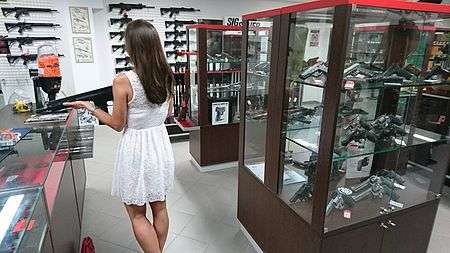
Historically, the country was at the forefront of spreading of civilian fireams ownership, as firearms became indispensable tools for the mostly peasant Hussite armies, whose amateur combatants, including women, fended off a series of invasions of professional crusader armies of well armored warriors with cold weapons in the 1420s and 1430s. The English term pistol originated in 15th-century Czech language.[6] Mariánská skála in Ústí nad Labem is Europe's oldest continually-open shooting range, established in 1617.[7] The Czech lands have been the firearms manufacturing center (including weapons industry) of Central Europe for over two centuries.[8] Firearms possession was severely restricted during German occupation and the subsequent communist dictatorship, with ownership rates gradually rising ever since the 1989 Velvet Revolution.
History
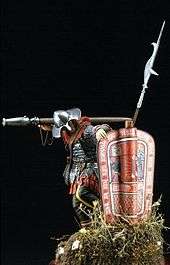
Firearms and religious freedom
Use of firearms as infantry weapons was pioneered in the Czech Crown lands in the early 15th century. In the 1420s and 1430s, the Czech Hussite army led by Žižka started using firearms and artillery effectively on the battlefield (it had previously been used only during sieges of towns and castles due to its heavy weight and cumbersome operation). Use of field artillery in the Battle of Kutná Hora was first such recorded utilization. Firearms, alongside wagon fort strategy, proved indispensable for the mostly peasant reformationist army in their war for religious freedom against professional well armed and trained Catholic Crusader invaders.[9] The word used for one type of hand held firearm used by the Hussites, Czech: píšťala, later found its way through German and French into English as the term pistol.[6] Name of a cannon used by the Hussites, the Czech: houfnice, gave rise to the English term, "howitzer".[10][11][12]
Gun regulation after the Hussite Wars
While invading crusader armies were composed of professional warriors, the hussite armies were largely relying on peasant fighting force. Male peasants were mostly armed with cold weapons made from farm equipment such as morning star, ball-and-chain flail, flail and various halberds but the hussite army included also female fighters. With clear physical and experience disadvantage against well armoured professional warriors, hussite combatants, especially women, relied heavily on firearms and crossbows. Firearms design underwent fast development during the hussite wars and their civilian possession became a matter of course throughout the war as well as after its end in 1434.[13]
The first Czech regulation of firearms was adopted as part of St. Wenceslaus Agreement of 1517. The agreement was signed between the Czech nobility and burghers after lengthy disputes over the extent of each other's privileges, as both began to fear possible widespread farmer and peasant uprising. While most of the agreement dealt with different issues, one paragraph set universal ban on carrying of firearms. This, in effect, made conventions of armed farmers and peasants illegal while preserving semblance of legal equality as the ban affected also the nobles and burghers. At the same time the 1517 agreement stated that "all people of all standing have the right to keep firearms at home" for purpose of protection in case of war.[13]
In 1524, mere seven years later, a comprehensive Enactment on Firearms (zřízení o ručnicích) was adopted. This lengthy act also focused on ban on carrying of firearms and set details for its enforcement and penalties. While almost entirely setting details of the carry ban, in its closing paragraph the act set a process of issuing carry permits. As permits could be granted either by nobility or by town officials, this put nobles and burghers in clear advantage over the farmer and peasant gun owners.[13]
The 1524 Enactment on Firearms also explicitly states the right of the nobles and burghers to keep firearms at home for personal protection. While not stating such right explicitly for the rest of the inhabitants, the fact that the enactment sets details of universal carry ban (unless a person has a firearm carry permit) with details of enforcement and penalties aimed at nobles, burgers and rest of the people respectively, makes it clear that they continued to have the right to keep firearms at their homes in line with the 1517 St. Wenceslaus Agreement.[13]
18th and 19th century gun laws
Under common law tradition, civilians could possess firearms except artillery and insidious weapons (e.g. firearms that had the appearance of other objects, etc.). Gun control laws enacted during the early 18th century dealt with illegal use of firearms for poaching. At the time, hunting was an exclusive noble privilege with little to no legal option for participation of common folk. Despite tough sentences of 12 years of hard labor or death introduced by a 1727 enactment, poaching with use of firearms remained widespread to the point that a 1732 Royal Gamekeeping Rules noted that gamekeepers were in constant danger of being shot by poachers.[14]
A 1754 enactment introduced up to one-year imprisonment for carrying of daggers and pocket pistols ("tercerols") as well as tough sentencing for cases of attacking or resisting law enforcement with use of these weapons. Mere brandishing of a weapon against a state official was to be punished by life imprisonment. Wounding a state official would be punished by decapitation, killing of state official by cutting of hand followed by decapitation. Another 1754 enactment limited possibility of shooting within limits of certain cities to licensed shooting ranges, showing early development of sport shooting in the country.[14]
A 1789 decree on hunting also included firearms related measures. Any person merely passing through someone's hunting grounds was obliged to either strip trigger off or wrap their firearm in cloth under penalty of confiscation as well as complete ban on firearms possession.[14] Other enactments limited use of firearms in cities "close to buildings" and on state roads (especially shooting to air during religious celebrations), citing fire hazard as a main concern. In general, however, people were free to possess and carry firearms as they wished, with another 1797 enactment specifying that loaded firearms at home must be kept in a way preventing their use by children.[14]
Gun control enactments adopted in the following three decades focused on banning of insidious weapons such as daggers or rifles hidden in walking sticks. Despite having been already banned under the 1727 law, foreword to 1820 enactment lamented their widespread presence among population both within cities as well as in the countryside.[14]
Imperial Regulation No. 223
Following power reconciliation after failed 1848 revolution, emperor Franz Joseph I enacted the Imperial Regulation No. 223 in 1852. According to the regulation, citizens had the right to possess firearms in a number "needed for personal use"; possession of unusually high number of firearms required a special permit. Pistols shorter than 18 centimeters (entire length) were banned altogether as well as rifles disguised as walking sticks. Firearms and ammunition manufacturing was subject to licence acquisition.[14]
The law also introduced firearm carry permits. A carry permit was available to person with clean criminal record subject to paying a fee. It needed to be renewed after three years. Certain civilians did not need a permit: hunters, shooting range members, those wearing traditional clothing that had firearm as customary accessory. During emergency state, carrying of firearms could have been provisionally prohibited.[14]
Another regulation of 1857 explicitly banned private ownership of artillery, while 1898 regulation lifted the ban on small pistols (shorter than 18 cm).[14]
Independent Czechoslovakia
After the establishment of independent Czechoslovakia in 1918, the country kept the gun law of 1852 (see above), i.e. the citizens had the right to possess firearms and needed to obtain a permit in order to be able to carry them.[15]
After Adolf Hitler's rise to power in Germany in 1933, local ethnic German party established its own private security force. In 1938, Hitler brought his demand for succession of part of Czechoslovak borderland that was inhabited mostly by ethnic Germans. The party's security force was transformed into a paramilitary organization called "Sudetendeutsches Freikorps" which started conducting terror operations against Czechoslovak state, Jews and ethnic Czechs. Especially snipers using scoped hunting rifles became particular concern. This led to adoption of Act No. 81/1938, on Firearms and Ammunition, which for the first time introduced licensing system not only for carrying of firearms, but also for firearms possession. Ministry of Interior was supposed to enact a regulation that would set rules for obtaining the licenses, however, this has not happened. Freikorps was receiving illegal shipments of firearms from Germany, making the envisioned licensing scheme useless. Thus, despite the new law, the enactment of 1852 still remained in force.
Nazi gun ban
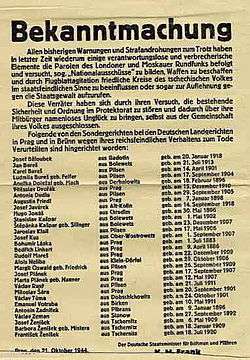
Germany, Poland and Hungary seized Czech borderland following the Munich agreement with UK, France and Italy, in October 1938, immediately putting into force their own restrictive gun laws within the occupied territory.
On 15 March 1939, Germany invaded the remainder of Czechoslovakia. On the very first day, Chief Commander of German forces ordered surrender of all firearms present within the occupied territory. This pertained not only to civilian-owned firearms, but also to those held by the police force. In August 1939, this order was replaced by Regulation of Reich Protector No. 20/39. The regulation again ordered the surrender of all firearms and introduced personal responsibility of land plot owners for all firearms that would be found within their property. Reich and Protectorate officials (including police) and SS Members were exempt from the gun ban. Licensed hunters could own up to 5 hunting guns and up to 50 pieces of ammunition. Long rimfire rifles, sport pistols up to 6 mm calibre, air rifles and museum guns were allowed, however they needed to be registered. Simple failure to surrender a firearm carried up to 5 years imprisonment, while hiding of cache of firearms carried the death penalty. Offenders were tried in front of German courts.[15]
Another Regulation of October 1939 ordered surrender of all books on firearms and explosives, as well as all air rifles "that look like military rifles", which was obviously aimed at vz.35 training air rifle that had appearance of vz.24 Czechoslovak main battle rifle.[15]
From May 1940 onwards, illegal possession of a firearm was punishable by death.[15]
Communist gun ban
The 1852 Imperial Regulation became again effective following the defeat of Germany in May 1945 and remained in force until 1950.[15]
In 1948, Communists conducted a successful coup in Czechoslovakia and started drafting a number of laws that would secure their grip on power, including the Firearms Act No. 162/1949 that became effective in February 1950. The new law introduced licensing for both possession and carrying. License to possess could be obtained from the District National (communist) Committee in case that "there is no concern of possible misuse". The same applied for license to carry, for which there was also a specific reason needed. Since 1961, the authority to issue license was given to local police chiefs, subject to the same requirements. Given that state apparatus constantly feared counterrevolution, only those deemed loyal to the party had any chance of getting a license.[15]
Ministry of Interior issued in June 1962 a secret guidance no. 34/1962 which specified conditions under which the police chiefs may have issued a license in accordance with the 1949 enactment. License to possess and carry short firearms may have been issued to named categories of persons (members of government, deputies, party functionaries, communist people's militia members, procurators, judges, etc.). Permit to possess and carry a long hunting rifle may have been issued only to "certified and reliable persons devoted to the socialist system". Referencing the secret guidance while issuing or denying the license was strictly forbidden.[15]
A new Firearms Act was adopted in 1983 as No. 147/1983. License remained may issue subject to consideration whether "public interest" doesn't prevent firearms possession by the given person. Apart from other formalities, the applicant needed to present also a declaration from their employer. Licenses were now available for sport shooting purposes, whereby the applicant needed to present recommendation of a local sport shooting society (which was run by the party). For the first time, the applicant also needed to be cleared by his general practitioner. Licenses were issued for a period of 3 years subject to renewal. Similarly as before, the enactment was accompanied by secret guidance of the Ministry of Interior No. 5/1984. The guidance again limited access to firearms to selected classes, mainly Communist Party members. Newly, sport shooters that achieved required performance bracket could also obtain license. Possession of hunting shotguns was less restrictive.[15]
Post Velvet Revolution liberal laws
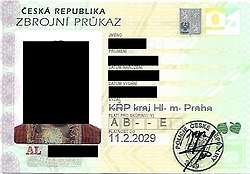
Following the Velvet Revolution, an amendment act No. 49/1990 Coll. was adopted. Under the new law, any person older than 18, with clean criminal record, physically and mentally sound that did not pose threat of misuse of the firearm could have license issued. License may have been issued for purpose of hunting, sport shooting, exercise of profession and in special cases also for protection (concealed carry). Newly, denial of license could be challenged in court.[15] Even though the law remained may issue, practice of issuing licenses became permissive.
A general overhaul of firearms legislation took place through act No. 288/1995 Coll. Under the new act, gun licenses became shall issue including for purposes of concealed carry for protection.[15]
Accession to EU required a new law compliant with the European Firearms Directive, which was passed in 2002. New law, which is effective to this day, on one hand introduced more EU mandated bureaucracy into the process of issuing of licenses and purchasing firearms, but at the same time streamlined some previous restrictions (e.g. newly not only pistols and revolvers could be possessed for purpose of self-defense, but any type of firearm).[15]
EU gun ban
Adoption of the Amending Directive (EU) 2017/853, commonly known as the "EU Gun Ban", necessitated major changes of Czech laws. As of December 2019, the Government was finalizing a draft of completely new firearms legislation that would find balance between the rights of Czech citizens and EU imposed obligations.
Current law
Cornerstones of current Czech gun law remain the same since the 1990s: precisely defined requirements that an applicant must meet in order to be granted a license. Once a person obtains the necessary license, the law is relatively permissive as regards both the type of firearms that become legally accessible, as well as possibility of their concealed carry for personal protection. At the same time, the issuing authority (police) firearm owners' database is connected to information needed for a background check and red flags any incidents that may lead to loss of license requirements. Similarly, health clearance by the general practitioner is needed for periodical renewal of license (every ten years).
Under Act No. 119/2002 Coll.[16] every citizen that meets the act's conditions has the right to have firearms license issued and can then obtain a firearm.[17][18] Holders of D (exercise of profession) and E (self-defense) licenses, which are also shall-issue, can carry up to two concealed firearms for protection.[19]
| License category | Age | Possession and ownership of firearm category | Ammunition restriction | Carrying | Note | No. (31 Dec 2019)[4] |
|---|---|---|---|---|---|---|
| A – Firearm collection | 21 | A (subject to may-issue exemption by police) B (subject to shall-issue permit) C (subject to later registration) |
3 pcs or 1 smallest production package of the same type, caliber & brand [20] | No carry | In case of ownership of any A category firearm, the person must allow access for inspection of its safe storage to police officers.[21] | 102,872 |
| B – Sport shooting | 18 15 for members of a shooting club |
B (shall-issue permit) C (later registration) |
None | Transport only (concealed, in a manner excluding immediate use) |
Gun can be transported only by person older 18 years of age | 159,425 |
| C – Hunting | 18 16 for pupils at schools with hunting curriculum |
B (shall-issue permit) C (later registration) |
None | Transport only (open/concealed, in a manner excluding immediate use) |
Subject to exemption by police, may use also night-vision (A category accessory)[22] | 113,576 |
| D – Exercise of profession | 21 18 for pupils at schools conducting education on firearms or ammunition manufacturing |
A, B, C (possession only, firearm remains in the ownership of the employer) |
Only ammunition for the firearm in possession (no restriction on quantity). | Concealed carry (up to 2 guns ready for immediate use) Open carry for members of Municipal Police, Czech National Bank's security while in duty |
66,231 | |
| E – Self-defense | 21 | B (shall-issue permit) C (later registration) |
Only ammunition for the firearm owned (no restriction on quantity). | Concealed carry (up to 2 guns ready for immediate use) |
248,278 | |
| Firearms Act | |
|---|---|
| Czech Parliament | |
Long title
| |
| Citation | No. 119/2002 Coll. |
| Enacted by | Czech Parliament |
| Enacted | 9 April 2002 |
| Commenced | 1 January 2003 |
| Introduced by | Miloš Zeman's Government |
| Related legislation | |
| Regulation of Ministry of Interior No. 221/2017 Coll., on Execution of Certain Sections of Firearms and Ammunition Act (Firearms Regulation) | |
| Status: In force | |
Categories of licenses
There are five categories of gun license; however, these should not be mistaken with the categories for guns.[23]
- A – Firearm collection
- B – Sport shooting
- C – Hunting
- D – Exercise of a profession
- E – Self-defense
Obtaining a license
An applicant applies for a gun license at a designated local office of the National police. If the conditions of age, qualification, health clearance, criminal integrity and personal reliability are met and a fee of 700 CZK (US$ 29.94) per category is paid, the license shall be issued in thirty days.[24] The license must be renewed every ten years[18] (no need to undergo qualification exam if the application is filed at least two months before termination of the previous license; health clearance still necessary[25]).
Age
To obtain a B or C category license, the applicant must be at least 18 years old. Under special circumstances, the applicant need only be 15 if a member of a sporting club, or 16 if taught hunting in schools with such a curriculum. To obtain an A, D or E category license, the applicant must be 21.[26]
Qualification
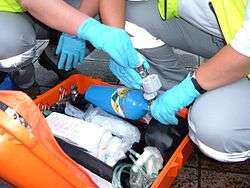
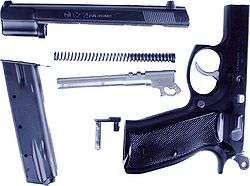
Obtaining the license requires passing a theoretical and practical exam.
- Theoretical exam: The theoretical exam consists of a written test of 30 multiple choice questions (Created and distributed by the Ministry of the Interior) with a maximum of 79 points possible. To pass the written exam, 67 points are needed for category A, 71 for category B or C, and 74 for category D or E.[27] The test deals with the following issues:
- Practical exam
- Safe handling:[32] this comprises
- Touching the trigger, pointing in different than appointed safe direction or trying to field strip loaded gun (dummy round is used) results in the applicant failing the exam. Depending on the categories of licenses sought, applicants may be asked to show their ability of safe manipulation on multiple firearms (typically CZ 75 and/or CZ 82 pistol, bolt-action CZ 452 rifle and a double-barreled shotgun).[36]
- Shooting test,[37] which requires specific scores dependent on the category of license applied for:
- For the B category license it is 25m on rifle target (A4 sheet sized) with 4 out of 5 rounds hitting the target sheet shooting from a rifle (2 out of five for A category). .22 Long Rifle chambered rifle is used.[38] Alternatively, an applicant can shoot a pistol on 50/20 pistol target at 10 m.
- For the C category license, the applicant must fires at 25m with a rifle (same as cat. B) and also successfully hit the rifle target from the distance of 25m shooting from a shotgun (Usually double-barreled), 3 out of 4 rounds must hit the target (at least partially).[39]
- For the E category license, the applicant must successfully hit the international pistol target 50/20 (50 cm x 50 cm) from a distance of 10m (15m for D category license) shooting from a pistol, 4 out of 5 rounds must hit the sheet (2 out of 5 for A category).[40]
- In each of the cases above, the actual score is irrelevant; the projectiles simply have to hit the target sheet within the circles.[41] Also in each case, the applicant is allowed 3 test shots to familiarize with the particular firearm used for the test. The shotgun is an exception to this, where only one round is allowed as a test shot.[42]
A person can obtain more or all of the categories at once. But the set of categories needs to be known before the exam and highest score needs to be met.[43] Typically, people obtain E and B category because these two categories provide the best versatility (almost any firearm can be owned and carried concealed). The D category is required by the law for the members of the municipal police (members of the state police do not need a license for on-duty firearms) and does not itself permit private gun ownership (unless the person obtains also other license category).[44]
Health clearance
Applicant (license holder) must be cleared by his general practitioner as being fit to possess, carry and use a firearm. The health check includes probes into the applicant's anamnesis (i.e. medical history) and a complete physical screening (including eyesight, hearing, balance). The doctor may request examination by a specialist in case he deems it necessary to exclude illnesses or handicaps stated in the respective governmental regulation. Specialist medical examination is obligatory in case of illnesses and handicaps that restrict the ability to drive a car.[45]
Governmental Regulation No. 493/2002 Coll.[46] divides the listed illnesses and handicaps into four groups, covering various issues from psychological and psychiatrical to eyesight and hearing (for example, the applicant must be able to hear casual speech over distance of 6 meters to be cleared for the E category). Generally, the regulation is more permissive when it comes to the license categories A and B, and more strict with view to the other categories, listing which illnesses and handicaps may curtail or outright prevent positive clearance by the general practitioner.[47] The outcome of the medical examination may be either full clearance, denial, or conditional clearance that lists obligatory health accessories (glasses, hearing aid, etc.) or sets obligatory escort when armed (e.g. B – sport shooters with minor psychological issues, or with addiction habits cured more than three years prior to the health check).[48]
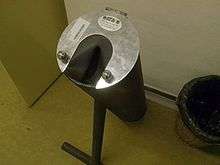
Criminal integrity
The enactment specifies the amount of time that must elapse after a person is released from prison for serving time for particular groups of crimes. Ex-convicts punished for committing selected crimes, such as public endangerment, or participation in organized crime group or murder, if sentenced to more than 12 years imprisonment, may never fulfill this condition.[49] There is a central registry of criminal offenses in the Czech Republic. The criminal integrity is reviewed notwithstanding any possible expungement of the records for other purposes.[50]
- After being conditionally discharged, the criminal integrity is regained after the probation period ends or in 3 years in special cases
- After serving less than 2 years or being sentenced to different kind of punishment than imprisonment, the criminal integrity is regained after 5 years
- After being sentenced for 2 to 5 years, the criminal integrity is regained after 10 years
- After being sentenced for 5 to 12 years, the criminal integrity is regained after 20 years
- After being sentenced for more than 12 years (for defined crimes, such as murder, treason, etc.) the criminal integrity is never regained.
Conditional discharge does not count, only the original sentence.
Police may order temporary seizure of firearm license and firearms in case that the holder is charged with any intentional crime, or a negligent crime connected with breach of duties relating to possession, carrying or use of firearms or ammunition.[51]
Personal reliability
A person who verifiably excessively drinks alcohol or uses illegal drugs, as well who was repeatedly found guilty of specified misdemeanors (e.g. related to firearms, DUI, public order, etc.) in the preceding three years, is considered unreliable for the purposes of issuing a gun license. The police has the right to inquire information regarding these issues also from municipal authorities (misdemeanors are dealt with by municipal authorities and there is no central registry related to them).[52]
Losing reliability is caused by:
- Committing a crime and being conditionally discharged, until the probation period ends.
- Excessive use of alcohol or addictive substances
- Committing multiple misdemeanors from specific segments of the law (Regarding Firearms, Explosives, Driving under influence, Czech Republic defense, public order, property and illegal hunting/fishing). Only one transgression in the last 3 years is tolerated. Other types of misdemeanors do not count to personal reliability criteria.
Police may order temporary seizure of firearm license and firearms in case that administrative proceedings against the holder are initiated for committing selected misdemeanors (e.g. carrying while intoxicated, refusing to undergo intoxication test while armed, shooting outside licensed range unless in self-defense).[51]
Obtaining of a license by a foreigner
The law distinguishes foreigners according to their country of origin. For selected foreigners, a license is shall-issue as same as for Czech citizens, while for others it is a may-issue.[53]
|
|
Foreign born residents are treated equally in the eye of Czech law (see above), but proof of a lack of criminal record in their country of origin must be provided;[54] persons having residence also in another EU country must provide documentation showing that they are allowed to own a firearm therein.[55] All the documents must be translated into Czech language by a sworn translator.[54]
Foreigners with registered place of residence in the Czech Republic may purchase firearms after obtaining corresponding licenses and permits; persons having residence also in another EU country must provide documentation showing that they are allowed to own such a firearm therein in order to be granted a permit to purchase a B category gun.[56]
The written test as well as the practical exam has to be taken in the Czech language. Until 31 December 2011, test-takers were allowed to use a sworn interpreter/translator, but this has since been forbidden.[57][58]
Categories of guns

Under the current gun law, guns, ammunition and some accessories are divided into four categories (these should not be mistaken with categories of licenses):
| Firearm category | Type of firearms | Requirements to acquire and possess | Number |
|---|---|---|---|
| A – Restricted firearms and accessories | Includes full automatic firearms, military firearms and ammunition not inspected and marked for civilian use, some types of ammunition such as armor-piercing and incendiary ammunition, night vision scopes, suppressors. The use of hollow point ammunition in pistols is also restricted, however, hollow points are legal to purchase for rifles and pistol carbines.[62] |
|
1,176 |
| B – Guns requiring permit | Includes semi automatic and single or multiple shot handguns, revolvers, semi automatic rifles and shotguns with magazine capacity over 3 rounds or with a detachable magazine, semi automatic "military" style rifles, rim-fire firearms under 280 mm of length and all shotguns under 600 mm of length, flare guns with caliber larger than 16mm.[63] |
|
414,980 |
| C – Guns requiring registration | Includes single shot or bolt action rifles longer than 280 mm, shotguns, semi-automatic rifles not included in B, air rifles with muzzle energy over 16 J and black powder repeaters.[64] |
|
418,232 |
| D – Guns available to adults above 18 | Includes air guns (muzzle energy up to 16 J), mechanical guns (with kinetic energy from 150 N), replicas (black powder up to two shots – e.g. not black powder revolvers), airsoft guns, vintage firearms (manufactured prior to 1890), expansion guns and .22 CB cap (muzzle energy up to 7.5 J).[65] | 18 years of age | N/A |
A person must obtain the Gun License (Zbrojní průkaz) to be allowed to own gun of categories A, B and C.[66] To own a gun in the D category only the age of 18 is required.[67] A, B and C category weapon has to be registered within 10 working day with the police after it is bought.[68]
Obtaining firearms
Each of the A, B, C and E categories of gun license allows the person to buy a B or C category of gun. Holders of an A category license may, after being granted may-issue exemption by the police, also purchase an A category firearm; holders of D category may possess and carry any category of firearm (which remains the property of the employer).[69]
In case of B license the person is allowed to use their guns at shooting ranges. The C license is required by other laws for hunting. The E license allows the person to own a gun for self-defense purpose and carry the concealed weapon. All guns need to be registered with the police in 10 working days after buying except for the D category.[69]
- To obtain a gun from the A category (typically a full-automatic or select-fire firearm), the person must ask for a may-issue "exemption" from the police and demonstrate a specific reason why they want such a weapon.
- For private physical persons, the only acceptable reason is collecting;[70]
- for physical or legal persons having an armament license (this is a completely different certificate than the gun license) for professional purposes the acceptable reasons include providing security for dangerous or valuable shipments or VIP objects, manufacturing or testing of firearms, providing training in use of A category firearms, or filming in case that the firearm is adjusted for use of dummy rounds.[70]
- The B category of guns (typically any semi-automatic firearm) requires permission from the police. Before buying the gun the person must visit the police and fill in the "permit to buy, own and carry" form for the particular weapon (depending on the police department, usually caliber and type of weapon is required).
- As a formality, a person must state a justifiable reason for purchasing a B category firearm, which include collecting, sporting, hunting or cultural activity, conducting business with firearms and ammunition, providing security, exercise of profession and self-defense.[71] The police will issue the permit in up to 30 days (usually immediately) and the permit is shall-issue if the applicant has a valid gun license (and fulfills all of its requirements, e.g. clean criminal record); the purchase permit is valid for 12 months.[72]
- The C category of guns can be bought at a gun shop after presenting the gun license. However, the gun needs to be registered later at the police.[74]
There is no limit in the law on the number of owned guns. The law specifies safe storage requirements for those owning more than two weapons or more than 500 rounds of ammunition. Additional safe storage requirements are stipulated for those owning more than 10 and more than 20 firearms.[73]
Possession of a firearm that does not belong to category D without a gun license (as well as sale, manufacturing, procurement, etc.) is a criminal offense which carries a penalty of up to two years imprisonment (up to eight years in defined cases).[75]
Shooting ranges
Firearm owners are allowed to practice only at licensed shooting ranges and may otherwise use the firearm only in case of self-defense, or when permitted by other laws (e.g. hunting).[76] As of 2014, there are almost two hundred places opened for the public.[77] Any adult can visit such a range and shoot from available weapons, without restrictions or permits. A person without a gun license has to be supervised (if younger than 18, then by a person at least 21 years old who has been a holder of a gun license for at least 3 years).[78]
Carrying a firearm
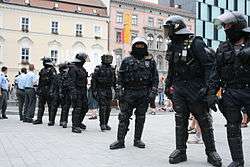
Holders of different categories of firearms licenses have different possibility of carrying their firearms. In general, it is prohibited to carry firearms to court buildings (they may be left for safe keeping with the judicial guard upon entry before passing through metal detector), at demonstrations or mass meetings.[79] It is also generally considered irresponsible to take guns to clubs or bars even though it is not explicitly prohibited by law. Carrying a gun while intoxicated is, however, illegal and can lead to heavy fines and losing the gun license,[80] with police frequently conducting intoxication tests of open-carrying hunters.[81] Carrying guns in schools and campuses is not prohibited by law and there are no so called "gun-free zones".[16]
The Czech Republic is a relatively safe country: Prague, with the highest crime rate in the country, still ranks as one of the safest capitals in the European Union.[82] Considering the number of E category licenses issued, there are about 240,000 people who could potentially carry a firearm; however, it is not clear how many regularly do so.[83]
License types
- No carry: Holders of A license (collection purposes) may only obtain and possess firearms (also those falling into the A – restricted guns category, subject to being granted a may-issue permit) and are not allowed to carry them or shoot with them.[84]
- Transport only: Holders of B (sport shooting) license may only transport their firearms to and from the areas designated for sport shooting. The firearms must be transported in a closed container and in a manner that excludes their immediate use.[85]
- Meanwhile, holders of C (hunting) license may too transport their firearms only to and from the areas designated for hunting in a manner that excludes their immediate use. In case that they use public transportation, the firearm must also be transported in a closed container, otherwise it may be transported (carried unloaded) openly.[85]
- Concealed carry: Holders of category D (exercise of profession) and E (self-defense) license may carry up to two firearms ready for immediate use (bullet-in-chamber). The firearms must be carried in concealed manner.[86] The requirement of concealed carry applies also for D holders of restricted firearms (e.g. private security with fully automatic firearms).[87]
- Open carry: Only the members of Municipal Police and of the Czech National Bank's security, as holders of D (exercise of profession) license, may carry their firearms openly while on duty.[88] Members of state police, prison service and other governmental security agencies do not need any gun license and are permitted/required by other laws to open or concealed carry while on duty.[89]
- Open carry may be allowed by police for special occasions, such as gun shows, war reenactments or liberation day celebrations; these are however technically referred to as "public display of firearm" rather than "carrying". Each person that wishes to "display" firearm must submit a request detailing the given occasion, firearm(s), their protection against theft, etc.[90] Also, during these occasions, the police often conducts inspections of gun holders regarding the respective paperwork and intoxication testing.[91]
Ammunition restrictions
All of the high-penetrating (armor-piercing) and hollow-point ammunition is classified as category A (see above).[62] The alternative to a hollow point ammunition was Federal EFMJ, which has been classified into the arms group A in mid 2009, effectively outlawing it. Therefore, only full metal jacket or soft-nosed semi-jacketed rounds and or just unjacketed bullets (lead only) are allowed. Generally, no ammunition with higher wounding potential is allowed.[92]
There is currently no restriction on caliber size and no restriction on magazine capacity. However, special safe storage requirements apply for those having more than 500, 10,000 and 20,000 bullets.[73]
Armament licences
Gun licences equivalent for legal persons, such as shooting ranges or private security companies. Divided into 11 categories.
- A – Development or manufacturing of firearms/ammunition
- B – Repairs, modifications or deactivation of firearms/ammunition
- C – Firearms/ammunition buying and selling
- D – Lending and safekeeping of firearms/ammunition
- E – Deactivation or destruction of weapons/ammunition
- F – Training in handling and using firearms/ammunition
- G – Providing security for persons/property.
- H – Cultural, sports and hobby shooting activities.
- I – Collecting and displaying firearms/ammunition
- J – Securing tasks defined by special legal enactments.
- K – Pyrotechnical Survey (Replaces F category gun licence in 2017)
Self defense with firearms
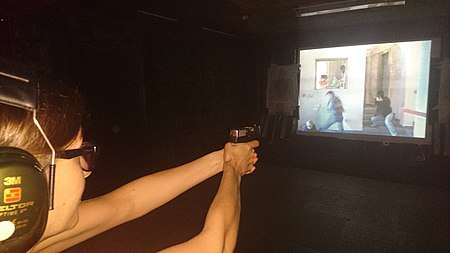
Czech law does not include specific provisions regarding self-defense with use of a firearm. Same rules apply as in case of unarmed defense or defense with any other weapon.
There are three main concepts in Czech law which exclude criminal & civil liability when using firearm. These include "utmost necessity" (krajní nouze), "necessary self defense" (nutná obrana) and other cases involving "eligible use of a gun" (oprávněné užití zbraně).[93]
Utmost necessity
Utmost necessity may be invoked when an ongoing danger other than an attack threatens an interest protected by the Criminal Code (such as right to property or right to life). Common examples include breaking through a car window in order to save a pet from heat or using neighbour's pool water in order to extinguish a fire.[94]
An example of an attack by a raging dog is commonly used to explain the difference between utmost necessity and necessary self defence. Only a person can commit an attack in a legal sense. Hence defensive action against a raging dog falls within the limits of utmost necessity, while defensive action against a dog that was directly ordered to attack by owner falls within limits of necessary self defense. This distinction is important as limits of defensive action taken under each of these concepts vary greatly.[94]
There are two main limitations to utmost necessity:[94]
- The consequences of defensive action may not be equal or greater than that of endangerment (proportionality).
- There is no other way of deflecting the danger than by taking the given action (subsidiarity), i.e. a concept cimilar to common law duty to retreat.
Necessary self defense
Necessary self-defense may be invoked to deflect imminent or ongoing attack against an interest protected by the Criminal Code (such as right to property or right to life) by performing an action which would otherwise be punishable (such as use of a firearm against the other person).[94]
Unlike in case of utmost necessity, there is no requirement of subsidiarity, i.e. no duty to retreat. There is also no requirement for proportionality as the law stipulates that defense may not be manifestly disproportionate to the manner of the attack.[95] The manner of attack includes everything from intensity of attack, attacker's personality, attributes and intent, possible previous actions by the attacker (threats, stalking, etc.), place and time of attack, numerical advantage and possibility of other persons joining the attacker, attacker's option to use a weapon, etc.[95]
It is generally accepted by Czech jurisprudence and case law that in order for defense to be successful, defensive action must exceed the intensity of the attack.[95] Case law on defining the limit of manifest disproportionality is highly developed. The Supreme Court defined prohibited manifest disproportionality of self defense as "absolutely unequivocal and exceptionally grossly excessive action", i.e. "action of the defender that absolutely clearly, apparently and undoubtedly does not fit all the decisive circumstances that characterize the manner of the attack".[95]
It is completely legal for a person to prepare for eventual need to defend themselves, including with weapons.[96] A person may also defend themselves against an attack that they provoked,[97] as long as they did not start offensive action or did not engage in mutual fight.[98] Defender may commence his action before attacker in case that an attack is imminent, however those cases are often difficult to prove.[99]
In case that a defender has multiple defensive options available (e.g. pepper spray and a firearm), they are not bound to escalate from the least effective to the most effective and they do not need to explain the choice they made. The only limitation is that the final choice, i.e. action taken, shall not be manifestly disproportionate to the manner of attack.[96]
The manner in which a weapon was used, not the use of a weapon alone is decisive as regards meeting of the limit of prohibition of manifestly disproportionate defense. I.e. a warning shot or shot intended towards non-critical part of attacker's body may be within the limits of necessary defense in cases where the manner of attack does not warrant a shot aimed into a critical part of body.[95]
Defensive action may not continue after an attack has ended. In case that the defender is prosecuted, proving that defense continued beyond the end of the attack is upon the prosecution and shall be decided in line with in dubio pro reo principle.[100]
Eligible use of a gun
Eligible use of a gun is addressed in special enactments dealing with police, secret security service, prison guards etc.[93] Thus for example a policeman may, under specified conditions, shoot on an escaping suspect, a privilege which an armed civilian does not have.[89]
Defensive gun use cases
Only slightly more than 3% of Czech adult population have concealed carry licenses. This together with a generally low rate of violent crime makes defensive gun uses relatively rare. More common are defensive knife uses, as there are no limitations on carrying of weapons other than firearms. Even more common are defensive uses of pepper sprays, the carrying of which is officially recommended by Ministry of Interior to women, elderly and other vulnerable groups.[101]
It is acceptable to use a firearm during defense against a violent attack especially when a person is attacked with a knife or another weapon. Shooting of unarmed attackers also occurs and becomes sometimes a subject of controversy. In general, each case is investigated in great detail before being eventually dismissed as legitimate self-defense.[102] The defense is judged according to the subjective and objective perception of the defender during the time of the imminent or ongoing attack, and not according to the view of persons who are judging it ex-post.[103] As regards home defense, there is no Castle Doctrine in the Czech Republic. Multiple attempts at introducing it into Czech law failed. Defense at home is thus judged similarly as at any other place.[102]
A number of successful defensive uses of firearms or other weapon is being cleared as legitimate self-defense by authorities every year without raising wider public concern, including for example a 2014 shooting of an attacker by a bartender in Hořovice,[104] or a 2014 shooting of an aggressive burglar in a garage by homeowner in Čimice.[105] However, some cases become rather notable, such as:
- 1991 defensive killing of a Nazi skinhead by a famous sculptor Pavel Opočenský, who attempted to help a couple that had been attacked on the street of Prague. Opočenský stabbed a 17-year-old metal-bar-wielding skinhead. The case included several reversals of Opočenský's conviction by higher court and significantly advanced case law on self defense. White power skinheads also conducted various protests throughout the many years of trials. A neo-nazi band Agrese 95 released a song titled "We shall go together and kill Opočenský."[106][107]
- In 1993, a group of five men decided to visit a friend who had previously brokered a deal, under which the men loaned 3,3 million CZK (US$120.000) to a Slovak entrepreneur. Instead of making quick profit on the loan, the men lost almost all of the loaned money. The broker first let the men into his house, but as the conversation heated up, he ordered them to leave. Due to their reluctance the broker ordered them to leave again, this time at gunpoint. While three of the men ran away from the house, the remaining two attacked the broker and managed to disarm him, at which point one shot went out from the firearm, not hitting anyone. The attack against the broker continued and included fingers being pushed into his eyes, which left him unable to see. The broker however managed to get hold of another firearm during the brawl, a six-shot Arminius HW .38 revolver and fired off five shots. Three of them turned out to be perfect headshots, instantly killing the attackers. The broker was first charged with double murder. Due to unusual circumstances, the police investigation ran for two years without indictment as the police ordered the making of several written expert opinions. The case was closed in 1995 as legitimate self-defense with charges being dropped.[108]
- In 2003, Slavoj Hašek was awoken by commotion from outside of his house. Hašek left his house with a shotgun and pursued a thief. After the thief got to his own car and drove it in Hašek's direction, he shot and killed him. Hašek was sentenced to five years imprisonment with the High Court in Olomouc arguing that the defense could not be legitimate, since the shot went through a side window rather than through the front windshield. Hašek was pardoned by President Václav Klaus shortly thereafter.[109]
- In 2006 a private security guard with a pistol pursued on foot two men whom he believed tried to steal scrap metal. The men climbed on a railway embankment and started throwing rocks down at the guard who thereafter shot ten rounds in their direction, mortally wounding one of them in the head. The guard was first convicted of murder by the Municipal Court in Prague and given a sentence of 7 years imprisonment. The decision was changed by the High Court in Prague to conviction of intentional infliction of bodily harm resulting in death (i.e. manslaughter) and a sentence of five years imprisonment. The guard was finally exonerated by the Supreme Court in Brno which considered his action legitimate self-defense, noting that defense must be clearly more intensive than attack in order to be successful, and that the stones and bricks being thrown presented grave danger to the man's life.[110]
- In 2009, a security system at a scrap metal yard, which had been repeatedly burglarized, went off. The yard's owner was at the time on a hunt close to the yard and drove directly to it. A group of burglars jumped into their car and attempted to drive away. The owner used his shotgun and attempted to shoot the car's tires, hitting and wounding two of its occupants. He was sentenced to 6 years imprisonment for intentional infliction of bodily harm, a sentence that was confirmed on appeal. The owner received full presidential pardon.[111]
- In 2010, a student from Azerbaijan was verbally attacked by a group of other foreigners in a bar in Prague. The student left the bar and proceeded to his friend's car, being followed by the group who continued to verbally attack him and his family and stating that "the issue needs to be solved immediately". The student recovered a knife from the car and took a stand. Thereafter one of the foreigners started punching him. The student stabbed one of the four attackers and then engaged in a fight with another, whom he stabbed in the leg and who bled to death. The Municipal Court in Prague convicted the Azerbaijanian student of intentional infliction of bodily harm with excusable motive and sentenced him to two years in prison. The decision was overturned by the High Court in Prague who considered the death an outcome of legitimate self-defense. The Supreme State Attorney mounted an extraordinary appeal to the Supreme Court, which however confirmed the acquittal, noting that the verbal abuse continued even after the victim got into the car and he could thus legitimately perceive it as an ongoing attack. The Supreme Court also refused the Municipal Court's previous line of argumentation that the victim could have easily left the place once in the car (as there is no duty to retreat under Czech law) as well as its reasoning that the threat did not reach such an intensity as to justify a lethal defense.[112][113]
- In 2012, two brothers in their early 20s, one of them armed with a knife, attacked a 63-year-old man in a town in the Northern Bohemian borderland. He shot both attackers with his legally owned pistol, killing one of them. The police closed the case as legitimate self-defense six months later and brought charges against the surviving attacker.[114]
- In the 2017 Chomutov incident, a 37-year-old man believed that a vehicular rampage is taking place in front of his home and in an effort to stop it, he shot the 34 year old driver dead. The ensuing court trial gained major public attention.
- In 2017, a man with criminal and drug abuse history attempted to rob a store in Prague, armed with a knife. He managed to stab the store clerk in the neck, but was then shot by store owner's wife and later died in hospital. Police ruled out the shooting as legitimate self-defense.[115] She was later awarded for the deed by the Prague City Council.[116]
- In 2018, a man riding a tram in Ostrava started attacking other commuters with a glass bottle and fist punches. When he started to stomp on a head of one of them, a woman with concealed carry license (E license) pulled out her handgun and ordered him to stop or be shot. He complied and stopped the attack. She later received a medal from the City of Ostrava for the deed.[117]
- In 2018, a drunk man refused to pay in a pub and verbally attacked a female bartender, another guest tried to defend the bartender but was attacked instead. The defender reached for his revolver, while being strangled on the ground, and fired a shot into the attacker. The attacker died. At first, the prosecutor didn't push any charges. Later, this case has been brought to court and ruled legitimate self defense.[118]
Popularity of guns
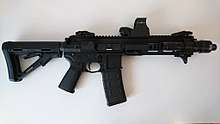
Given that firearms possession was banned during German Nazi occupation and then allowed only to those deemed loyal during the Communist regime, the right to be armed is seen as one of attributes of liberty in the country. Together with rapid rise of criminality involving illegal firearms following the Velvet Revolution, this led to fast rise in legal firearms ownership in the country in the 1990s. By 2001, some 3% of population possessed firearms licenses. The number of license holders was falling slightly from this point (faster as regards C licenses, while E licenses remained mostly level) until the 2015 EU Gun Ban Proposal, from which point the number of license holders began to rise again (mostly E licenses).[2] The police recorded a tripling of average monthly applications for firearms licenses by the end of 2015 compared to the beginning of that year.[119]
While the number of license holders started to rise gradually, firearm sales rose even faster in 2015, mostly prompted by the EU efforts to restrict law abiding citizens' access to firearms.[120] Average annual rise in the number of registered firearms amounted to 14,500 guns between 2006 and 2014, there were 54,508 new registered firearms in 2015 alone.[3] Local tendencies generally follow the nationwide trend, however any worsening of security in any given district is often followed by a sharp rise in gun ownership therein. For example, in 2011, after a wave of racially motivated attacks by Romani perpetrators against majority population victims, there was a rise of gun ownership in Šluknov Hook area.[121]
248,278 out of 305,452 (2019) gun owners have self-defense licenses, which permit them to carry concealed firearms for protection (any B or C category firearm, not only pistols). Following a wave of terror attacks around Europe, a number of politicians as well as security professionals started urging gun owners to actually carry firearms in order to be able to contribute to soft targets protection. These included, among many others, the President Miloš Zeman, whose own wife obtained E license and a revolver,[122] as well as Libor Lochman, Chief of URNA, the country's main special forces anti-terrorism unit.[123] While there are no statistics as regards how many E license holder actually do carry firearms in general, there are places known for high concealed carry rate, such as Prague Jewish Quarter.[124]
Unlike elsewhere in Europe, there is a relatively high proportion of semi-automatic firearms in the country, which are generally considered better suited for self-defense. The most owned firearms in the country are CZ 75 Compact and Glock 17.[125] Other popular guns include 1911 clones and semi-automatic rifles made by Czech manufacturers, especially vz. 58 and AR-15 (of which there are 5 domestic manufacturers). There are relatively fewer revolvers, mostly from US manufacturers such as Smith & Wesson and Colt, or Czech producers ALFA and Kora.[59]
Incidents and gun crimes
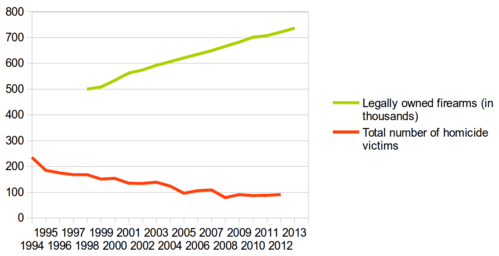
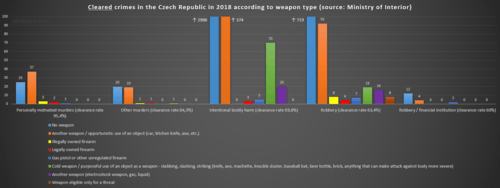
It is generally not common for licensed gun owners to commit violent crimes with their guns, and most of the gun crimes are committed with illegal weapons that are beyond the control of the law.[127] Annually, police investigate about 500 cases of illegal arming (with or without direct connection to committing other crime).[125]
Police recorded 45 violent crimes (most of them, 17, being "dangerous threats" and 6 homicides - including attempts, mostly intra-family) being committed with legal firearms (A,B,C category) in 2016, down from 71 in 2014 and 51 in 2015 respectively. Meanwhile, illegally possessed firearms (A,B,C category) were used in 71 violent crimes (9 murders) in 2016. When resorting to use of firearms, perpetrators mostly utilize non-lethal free-to-buy D category weapons (see above) that resemble real guns, with 906 such crimes taking place in 2016.[128] Apart from simple threats, the most common crime committed with firearms is robbery. Out of 1.500 robberies recorded in 2016, 153 took place with use of D category free-to-buy non-lethal weapons, 24 with illegally possessed firearms and 3 with legally possessed firearms (out of over 800,000 legally owned firearms).[128]
It is important to note that Czech police records completed and attempted homicides in the same category. The total number of people shot dead (homicides, police action, self defense), without distinction of legal or illegal source of gun, is recorded by CZSO. CZSO recorded 7 gun related assault deaths in 2016, 9 in 2017 and 5 in 2018.[129]
In 2018, police recorded three homicides with legally held firearms including attempts of which one was subsequently ruled self defense and the other was ruled manslaughter with only a probation sentence, leaving a single criminal murder.[130]
Overall, legally held firearms are implicated in about 3.5% of murders including attempts while 7% of the adult male population owns one (adult males are responsible for about 90% of murders in the Czech Republic).[131]
Occasionally, crimes with legally owned guns do happen. The most notable examples include:
- 2001 shooting of three policemen who were called by a woman claiming she was being attacked by her husband. On the scene, the policemen were negotiating with the husband who was threatening to commit suicide with his legally owned .38 revolver. When the situation seemed about to be peacefully solved, the hysteric wife ran into the room. The husband thereafter shot three policemen (two mortally) and committed suicide.[132]
- 2005 "Forest Killer", who was planning to go on a killing spree in Prague Metro. As part of his preparation, the former policeman randomly murdered two hikers in a forest and another person four days later in another forest about 200 km from the first killing with his legally owned Glock. Police captured Kalivoda a week later, thus preventing further murders.[133] Kalivoda was sentenced to life imprisonment. While in prison, he committed suicide in 2010.[134] Being a former policeman, Kalivoda had passed a difficult psychological evaluation as part of the police selection procedure.[135]
- 2013 Raškovice shooting, where a 31-year-old schoolteacher invaded house of one of his students, aged 17, with whom he had allegedly been previously intimately involved, and shot the student and her grandparents, using various legally owned firearms (with caliber .22, .38 and .45). The perpetrator had passed psychological evaluation ordered by his general practitioner before getting gun license. He was sentenced to 27 years imprisonment.[136][137][138]
- 2015 Uherský Brod shooting, the second mass murder committed with a firearm in the country's peacetime history, in which a deranged individual murdered 8 people (same death toll as Olga Hepnarová's 1973 vehicular murder). He was a holder of a gun license and legally owned both of the guns he used in the shooting. Previously, he and his wife committed misdemeanors against public order, which would have allowed police to revoke his license.[139] The first mass murder with use of a firearm in modern (post 1993) Czech history happened in 2009 in Petřvald with four victims and the third happened in 2019 in Ostrava with seven people shot dead; both were committed with illegally held handguns.[140]
General attitudes to guns and efforts to change the law
Those who [legally] carry guns are the most polite citizens. We don't take part in brawls, we don't quarrel on the street, we don't drink & drive even with the lowest amount of alcohol in blood, because so little may be sufficient to lose the gun license and being forced to sell the gun.
— Stanislav Gibson, director of Lex, a Czech firearms owners' lobby association[59]
The gun law in the Czech Republic is quite liberal. It is mostly caused by the fact that after the fall of communist regime people wanted to regain their rights to keep and bear arms and these needs resulted in passing quite liberal legislation in 1995, which surpassed the previous restrictive communist enactment. The law became widely accepted and led to quite massive civilian arming. Especially many businessmen felt the actual need to obtain a firearm because the times shortly after the Velvet Revolution are known for the rise in organized crime often related to the economic transformation in the early 1990s.[141]
The biggest attempt on restricting firearm ownership happened in 1999, Minister of the interior Václav Grulich proposed a new law, compliant with the EU requirements, which would severely restrict gun ownership by requiring the membership in a sports club for sports license and proof of "danger to life" for concealed carry permit and self-defense gun ownership. However, the proposal sparked opposition in the Chamber of deputies, the main concern being immense corruption potential in the proposed "may issue" doctrine, and the proposal was rejected by all parties in the chamber, except for Social Democrats, the party of Grulich himself. 5 years earlier, a similar motion was proposed by Zdeněk Trojan, a deputy for ČSSD, in a form of amendment to a government proposed firearms act (the one that was enacted in 1995) but found very little support and was rejected.
Due to falling crime rates, fewer people felt the need to carry a firearm for protection after 2000. This trend however changed in 2015 following the European migrant crisis and November 2015 Paris attacks. Gun advocacy groups argue that there is no point in banning guns because criminals will get guns no matter how tight the law is.[59] At the same time, however, the rules are deemed to be restrictive enough to prevent criminals from easily obtaining firearms, while allowing upstanding citizens to own them for personal protection. For example, in 2010, a Norwegian terrorist, incited by reports of British newspapers describing Prague as "being the most important transit site point for illicit weapons in Europe", found himself unable to obtain any in the country when preparing for the 2011 Norway attacks.[142][143][144] Similarly, a Polish terrorist obtained guns illegally in 1200 km distant Belgium, despite living mere 70 km from the Czech border.[145] Also, the fact that Czech Republic has a strong tradition in firearms manufacturing and competition shooting contributes to generally moderate attitude to gun control.[59]
Obligatory psychological testing for gun owners is a common subject of discussion, but it has always been rejected. Gun advocates point out that the nature of the tests and the parties responsible for them are not clear. It is also pointed out that it is unlikely that any psychological testing would reveal a potentially dangerous individual, because some famous killers in the past were members of the military or the law enforcement and passed very difficult psychological testing successfully.[135]
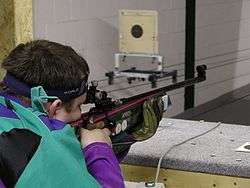
The most important changes to the 2002 Firearms Act were the following:
- 2004 – inclusion of pyrotechnical survey under the act (new category F license)
- 2005 – change of definition of historical firearms (i.e. D Cat not requiring license) from "developed or manufactured prior to 1890" to "manufactured prior to 1890" (i.e. functional replica possession requires license)
- 2008
- inclusion of citizens of European Economic Area and Switzerland under the same set rules pertaining to citizens of EU countries
- tighter sanctions for use of firearms (concealed carry, hunting, shooting at ranges) while intoxicated (loss of license)
- 2009 – exemption for A category firearms may now be given only A category license holder (e.g. exemptions for fully automatic firearms would newly be given only for firearms collection purposes, not for self-defense), A category firearms may not be conceal carried any more,
- 2014
- new licenses issued for 10 years instead of 5
- in case that police has a well founded suspicion that the gun owner's state of health has changed so as to lead to loss of his health clearance, they may ask him to present a new health clearance, failure to do so within 30 days may lead to revocation of license
- new possibility of license owner to surrender the license, if he wishes to do so
- possibility of B and C category license holders to obtain exemption for A category accessories (e.g. night vision scope for hunters)
- E category license holder allowed to reload ammunition for their own purposes (before, only B and C category license holders)
- 2016
- in case that police have a well founded suspicion that the gun owner's state of health has changed so as to lead to loss of his health clearance so that he may present danger to self or others, they may provisionally seize his firearms and ammo; in case that the given person fails to comply, police may also enter his home without judicial warrant to do so; however, firearms must be returned to the owner immediately after reasons for seizure expire (e.g. owner presents new health clearance) – adopted in reaction to Uherský Brod shooting
- police allowed to enter home and other premises without judicial warrant in case that other reason for seizure of firearms exists and the owner has failed to surrender them (e.g. indictment for intentional felony)
- police use new registry of misdemeanors for determination of personal reliability – adopted in reaction to Uherský Brod shooting
- 2017 (effective since August 2017, delayed part of 2016 amendment)
- laser sights are not A category accessory any more
- government loses authority to order surrender of firearms during state of emergency or war
- F category license no longer issued, transferred to armament license
About a fifth of members of the Czech Parliament are holders of gun license; some of them are believed to conceal carry also within the parliament grounds (parliamentarians are not required to pass gun check on entry unlike other staff or visitors).[146]
2014 European parliamentary elections
Generally, firearms possession is not a politicized issue that would be debated during Czech elections. The 2014 European Parliament election became an exception in connection with the Swedish European Commissioner Cecilia Malmström's initiative to introduce new common EU rules that would significantly restrict the possibilities of legally owning firearms.[147]
In connection with that, a Czech gun owners association asked the parties running in the elections in the Czech Republic whether they agree (1) that the citizens should have the right to own and carry firearms, (2) that the competence on deciding firearms issues should lie in the hands of the nation states and not be decided on the EU level, and (3) whether they support Malmström's activity leading to the curbing of the right of upstanding citizens to own and carry firearms. Out of 39 parties running, 22 answered. The answers were almost unanimously positive to the first two questions and negative to the third one. Exceptions were only two fringe parties, the Greens – which, while supporting the right for gun ownership in its current form, also support further unification of rules on the European level and labeled the opposing reaction to Malmström's proposal as premature, and the Pirates which support unification of the rules leading to less restrictions elsewhere, commenting that one may not cross the borders out of the Czech Republic legally even with a pepper spray. Other fringe parties at the same time voiced their intent to introduce American style castle doctrine or to arm the general population following the example of the Swiss militia.[148]
2015 European Union "Gun Ban" Directive
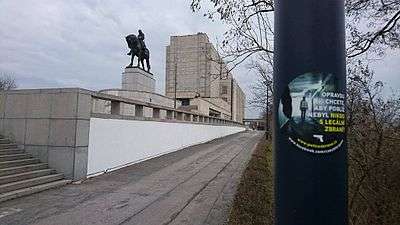
A sticker promoting petition against EU Gun Ban on a lamp post at the National Monument in Vitkov, Prague.
The European Commission proposed a package of measures aimed to "make it more difficult to acquire firearms in the European Union" on 18 November 2015.[149] President Juncker introduced the aim of amending the European Firearms Directive as a Commission's reaction to a previous wave of Islamist terror attacks in several EU cities. The main aim of the Commission proposal rested in banning B7 firearms (and objects that look alike), even though no such firearm has previously been used during commitment of a terror attack in EU (of 31 terror attacks, 9 were committed with guns, the other 22 with explosives or other means. Of these 9, 8 cases made use of either illegally smuggled or illegally refurbished deactivated firearms while during the 2015 Copenhagen shootings a military rifle stolen from the army was used.)[150]
The proposal, which became widely known as the "EU Gun Ban",[151][152][153][154] would in effect ban most legally owned firearms in the Czech Republic, was met with rejection:
- Government Resolution No. 428/2016 of 11 May 2016[155]
- The Government tasks the Prime Minister, the First Vice-Prime Minister for Economy and Minister of Finance, Minister of Interior, Minister of Defense, Minister of Industry and Trade, Minister of Foreign Affairs, Minister of Agriculture and Minister of Labor and Social Affairs to (1) conduct any and all procedural, political and diplomatic measures necessary to prevent adoption of such a proposal of European Directive, that would amend the Directive No. 91/477/EEC in a way which would excessively affect the rights of the citizens of the Czech Republic and which would have negative effect on internal order, defense capabilities and economical or labor situation in the Czech Republic and (2) enforce such changes to the proposal of directive that would amend the directive no. 91/477/EEC that will allow preservation of the current level of civil rights of citizens of the Czech Republic and which will prevent negative impact on internal order, defense capabilities and economical and labor situation in the Czech Republic.
- Resolution of Chamber of Deputies No. 668/2016 of 20 April 2016[156]
- The Chamber of Deputies (1) expresses disapproval with the European Commission proposal to limit the possibility of acquisition and possession of firearms that are held legally in line with national laws of EU Member States, (2) refuses European Commission's infringement into a well established system of control, evidence, acquisition and possession of firearms and ammunition laid down by the Czech law, (3) expresses support for establishment of any and all functional measures to combat illegal trade, acquisition, possession and other illegal manipulation with firearms, ammunition and explosives, (4) refuses European Commission's persecution of Member States and their citizens through unjustified tightening of legal firearms possession as a reaction to terror attacks in Paris and (5) recommends the Prime Minister to conduct any and all legal and diplomatic steps to prevent enactment of a directive that would disrupt the Czech legal order in the area of trade, control, acquisition and possession of firearms and thus inappropriately infringe into the rights of the citizens of the Czech Republic.
- Senate Resolution No. 401/2016 of 20 April 2016 [157]
- Senate (…) (2) points out that the Commission’s directive proposal should be primarily aimed at illegal acquisition and possession of firearms, their proper deactivation and illegal firearms trade, as it is illegal firearms that are used during terror attacks, not firearms possessed in line with law of Member States and thus (3) disagrees with measures proposed in the directive that would lead to limitation of legal firearms owners and to disruption of internal security of the Czech Republic without having any clear preventive or repressive impact on persons possessing firearms illegally; such measures are contrary to the principles of subsidiarity and proportionality (...)
- Joint Declaration of Ministers of the Interior of Visegrad Group of 19 January 2016[158]
- The Ministers are fully aware of the need to fight actively against terrorism. As regards the regulation of the possession of firearms, it is necessary to focus the adopted measures primarily on illegal firearms, not legally-held firearms. Illegal firearms represent a serious threat. Within the European Union, it is necessary to prevent infiltration of illegal firearms from the risk areas. It should be taken into account that bans on possession of certain types of firearms that are not, in fact, abused for terrorist acts can lead to negative consequences, especially to a transition of these firearms into the illegal sphere. The V4 states have profound historical experience with such implications.
Ministry of Interior published in May 2016 its Impact Assessment Analysis on the proposed revision of directive No. 91/477/EEC. According to the Ministry, the main impacts of the proposal, if passed, would be:[159]
- Risks to internal security: According to Czech Ministry of Interior, the main danger of the proposal rested in massive transfer of now legal firearms into illegality, with up to hundreds of thousands of legal firearms entering black market. While the original Commission proposal would affect 40,000 – 50,000 firearms legally possessed by Czech citizens, Dutch EU Council Presidency proposal of 4 April 2016 would affect some 400,000 legally owned firearms, i.e. making half of all Czech legally owned firearms illegal with large proportion of gun owners likely refusing to surrender their firearms. The proposal as such is in direct contradiction with Ministry's long-term objective of lowering of number of illegal firearms and of conducting effective supervision of firearm owners.
- Risk to defensive capabilities: Security forces are not changing armaments annually, and thus small arms manufacturers need civilians as key customers. Crippling of civilian firearms market would likely lead to end of firearms manufacturing in the Czech Republic. At the same time, familiarity with semi-automatic versions of army rifles by civilians is a clear defensive advantage in case these people need to be drafted to defend the country.
- Threat to national culture: The proposal would lead to permanent deactivation of firearms owned by collectors and museums, including army museums, even though there is no empirical data supporting need for such a measure.
- Rise of unemployment: The proposal would lead to cancellation of tens of thousands of work places in the Czech Republic alone.
- Impact on hunting: Semiautomatic rifles have been purposefully used for hunting in the Czech Republic since at least 1946 and they are especially effective and popular in curbing wild boar overpopulation that is responsible for large number of car accidents as well as damage to agriculture. Banning of these firearms would likely lead to increase of car accidents due to collisions with wild animals and consequent increase in number of injuries and fatalities.
- Impact on state budget: As Czech constitution does not allow confiscation without remuneration, the government would have to pay up to tens of billions Czech crowns (billions of Euros) as compensation for banned firearms. Meanwhile, rise in unemployment would further impact budget income.
Despite reservations of the Czech Republic and Poland, the Directive was adopted by majority vote of the European Council and by first reading vote with no public debate in the European Parliament. It was published in the Official Journal under No. (EU) 2017/853 on 17 May 2017. Member States will have 15 months to implement the Directive into its national legal systems. The Czech Government announced that it will lodge a suit against the directive in front of the European Court of Justice, seeking postponement of its effectiveness as well as complete invalidation,[160] and did so on 9 August 2017.[161]
2016 Constitutional Amendment Proposal (failed)
1. The security of the Czech Republic is provided by the armed forces, armed security corps, rescue corps and emergency services.
2. The state authorities, territorial governments and legal and natural persons are obliged to participate in the provision of security of the Czech Republic. The scope of duties and other details are set by law.
3. Citizens of the Czech Republic have the right to acquire, possess and carry arms and ammunition in order to fulfill the tasks set in subsection 2. This right may be limited by law and law may set further conditions for its exercise in case that it is necessary for protection of rights and freedoms of others, of public order and safety, lives and health or in order to prevent criminality. [162]
— Proposal to amend Article 3 of Constitutional Act no. 110/1998 Col., on Security of the Czech Republic lodged by 36 MPs on 6 February 2017 (Subsection 1 & 2 are preexisting, subsection No. 3 is newly proposed in the Amendment.)
Ministry of Interior proposed a constitutional amendment on 15 December 2016 aimed at providing constitutional right to acquire, possess and carry firearms. The proposed law would, if passed, add a new section to Constitutional Act No. 110/1998 Col., on Security of the Czech Republic, expressly providing the right to be armed as part of citizen's duty of participation in provision of internal order, security and democratic order.[163]
According to explanatory note to the proposal, it aims at utilisation of already existing specific conditions as regards firearms ownership in the Czech Republic (2.75% of adult population having concealed carry license) for security purposes as a reaction to current threats – especially isolated attacks against soft targets. While there is constitutional right to self-defense, its practical utilization without any weapon is only illusory.[163]
The note further elaborates that unlike the rest of the EU, where most guns are owned for hunting, the vast majority of Czech gun owners possess firearms suitable for protection of life, health and property, explicitly mentioning, inter alia, semi-automatic rifles (which are subject to the proposed EU Gun Ban, see above).[163]
As regards adherence to EU law, the explanatory note states:[163]
- The proposal falls outside of jurisdiction of EU law, as
- Article 4(2) of TEU respects basic functions of state, including maintenance of public order and provision of national security.
- Article 72 of TFEU states that "This Title shall not affect the exercise of the responsibilities incumbent upon Member States with regard to the maintenance of law and order and the safeguarding of internal security."
- Article 276 of TFEU: "In exercising its powers regarding the provisions of Chapters 4 and 5 of Title V of Part Three relating to the area of freedom, security and justice, the Court of Justice of the European Union shall have no jurisdiction to review (...) the exercise of the responsibilities incumbent upon Member States with regard to the maintenance of law and order and the safeguarding of internal security."
- The proposal falls outside of scope of the Firearms Directive, as
- territorial authority of the proposal falls strictly within the Czech Republic
- personal authority of the proposal falls strictly on citizens of the Czech Republic and does not extend even to EU foreigners living in the country
- the proposal does not deal with acquisition of firearms for the purposes of hunting and sport shooting, which are the main areas that the Firearms Directive is concerned with
The Minister of Interior Milan Chovanec stated that he aims, due to pressing security threats, at having the proposal enacted before the autumn 2017 Czech Parliamentary Elections.[164] The right to be armed further became a major political issue with explicit impact as regards possible future Czech-EU relationship and membership, when the Civic Democratic Party took a pledge to "defend the right of law abiding citizens to be armed even if it would mean facing EU sanctions."[165]
On 6 February 2017, Minister Chovanec and 35 other Members of Chamber of Deputies of the Czech Parliament officially lodged proposal of the constitutional amendment with modified wording. In order to pass, the proposal must gain support of 3/5 of all Members of Chamber of Deputies (120 out of 200) and 3/5 of Senators present. Explanatory note to the proposal states that it aims at preventing significant negative impacts of proposed EU Firearms Directive amendment that would lead to transition of now legal firearms to black market. It aims to utilize to the maximum possible extent both exemptions of the Directive proposal as well as the sole authority of national law provided in the EU's primary law for issues of national security [162] The legislative process continued as follows:
- 27 February 2017: the proposal was discussed by the Government of the Czech Republic, showing a clear split between coalition parties as all 7 ČSSD Ministers supported the proposal, while ANO and KDU-ČSL Ministers either rejected it or abstained. Lacking majority in either way, the Government didn't take any official position on the proposal.[166] Legally, under the Article 44(2) of the Czech Constitution, failure to declare any opinion on a proposed act by Government means that the Government supports the proposal.[167] Government's position is only advisory.
- 12 April 2017: The proposal entered first reading in the Chamber of Deputies. There were altogether 57 entries of MPs and Ministers into the debate. None proposed vote for dismissal. The proposal was assigned to Constitutional Committee (143 votes out of 146 present) and to Security Committee (136 votes out of 147 present) to make an advisory recommendation. The Committees' time for deliberation was shortened to 54 days (98 to 25 outcome out of 147 present).[168]
- 19 April 2017: Following discussion, the Security Committee endorsed the proposal by a vote of 10 to 1.[169]
- 31 March 2017: The Constitutional Committee endorsed the proposal. Out of 12 present deputies, 11 supported it and 1 abstained from voting.[170]
- 7 June 2017: The proposal entered second reading in the Chamber of Deputies. With no motions for dismissal or for changes of the lodged text, the proposal moved to third reading in line with recommendation of the two Committees representatives, whose were the only entries into the debate concerning the proposal.[171]
- 28 June 2017: The proposal entered third and final reading in the Chamber of Deputies. After nearly 3 hours of debate, the proposal passed with 139 votes. Only 9 deputies voted against it. The proposal was supported by Social democrats (40 voted in favour, 3 abstained or didn't log in), ANO (39 voted in favour, 1 against, 3 abstained or didn't log in), Communist party (24 voted in favour, 1 against, 7 abstained or didn't log in), Civic Democrats (All 15 present deputies voted for) and the original Dawn of Direct Democracy deputies (9 voted in favour and 3 abstained or didn't log in).The support was much lower in TOP 09 (9 voted in favour, 2 against and 11 abstained or didn't log in) and especially KDU-ČSL (3 voted in favour, 5 against and 4 abstained).[172]
- 24 July 2017: The proposal was officially handed over from the Chamber of Deputies to the Senate. Before this happened, the Permanent Senate Committee for Constitution and Parliamentary Procedures adopted on 11 July 2017 Resolution No. 5 which labels the proposal as "useless and potentially harmful".[173] Out of 8 Senators and non-senate members of the committee present, 6 supported the Resolution proposed by Committee's chair and former Constitutional Court Justice Eliška Wagnerová. Two senators abstained.[174]
- 5 October 2017: A petition against the EU Gun Ban signed by over 100.000 citizens was debated during a public hearing in the Senate. Apart from the EU Directive, the debate largely centered on the proposed amendment.[175]
- The plenary session of the Senate postponed a vote on the proposal planned on 11 October 2017 to a later date.
- The Senate voted on the proposal on 6 December 2017. Only 28 out of 59 Senators present supported the proposal, failing to reach the 36 votes necessary. The proposal was thus sacked.[176] On the same day, the Senate adopted a resolution calling upon the Government not to implement parts of the EU Gun Ban that are not related to fighting terrorism, i.e. restrictions legal firearms that had not been used during commitment of any of terror attacks.[177]
(1) Everyone has the right to life. Human life is worthy of protection even before birth.
(2) Nobody may be deprived of her life.
(3) The death penalty is prohibited.(4) Deprivation of life is not inflicted in contravention of this Article if it occurs in connection with conduct which is not criminal under the law. The right to defend own life or life of another person also with arms is guaranteed under conditions set out in the law.[178]
— Proposal to amend Article 6 of Charter of Fundamental Rights and Freedoms lodged by 35 Senators on 24 September 2019 (Text in italics is preexisting, the last sentence in subsection 4 is newly proposed in the Amendment.)
The proposal is expected to be submitted again in Parliament after the 2018 autumn Senate elections, which ended with a decisive victory for ODS, a conservative party in favor of the amendment.[179] However, current President of the Senate, Jaroslav Kubera (ODS), claims that it would have "no chance to pass", simply due to the fear of allowing any changes to the Constitution and Constitutional acts due to current political situation (As PM Andrej Babiš has frequently expressed his plans to rewrite the constitution, for example to abolish the Senate or change the electoral system).[180]
2019 Constitutional Amendment Proposal (ongoing)
On 24 September 2019 a group of 35 Senators lodged formal proposal to amend the Charter of Fundamental Rights and Freedoms to include right to defend life with arms. The proposal was drafted by senator Martin Červíček, retired police brigadier general and 2012 - 2014 Police of the Czech Republic president.[178] The proposal is planned for debate during a Senate meeting in October 2019. The Senate may formally propose adoption of the amendment through a simple majority of votes. In order to pass, the proposal must gain support of 3/5 of all Members of Chamber of Deputies (120 out of 200) and then be voted through the Senate again, this time with majority of at least 3/5 of Senators present.
Senate voted on formal proposal of the Constitutional Amendment on its vote held on 11 June 2020. 41 out of 61 senators voted for the measure. That was sufficient to start the legislative process, i.e. to submit the proposal for the vote at the Chamber of Deputies, for which a simple majority is needed. However the number fell one vote short of reaching constitutional majority. Constitutional majority must be reached once the amendment is accepted by the Chamber of Deputies and bill moved back to Senate for final approval.[181]
Other types of weapons
There is currently no regulation on other type of weapons such as knives, pepper sprays, batons or electrical paralyzers. These items can be freely bought and carried.[101] Similarly as in the case of firearms, it is prohibited to carry these weapons to court buildings, demonstrations and mass meetings.[182] The Ministry of the Interior officially recommends carrying non-lethal weapons such as pepper sprays, paralyzers, or gas pistols as means of self-defense[101]
The Czech penal code defines "weapon" as "anything that may make an attack against the person more severe".[183] Although there are no restrictions on possession and carrying of weapons, their use in commission of a crime is punishable by stiffer sentences. For example, blackmail carries six months to four years imprisonment, but blackmail with a weapon carries four to eight years imprisonment.[184]
References and sources
- Šimek, Jiří (18 December 2012). "Statistika držitelů zbrojních průkazů a počtu registrovaných zbraní 1990-2010" (in Czech). Gunlex. Retrieved 31 August 2013.
- "Gun license statistics between 2003–2012" (in Czech). Gunlex. Retrieved 12 August 2013.
- "V ČR loni mělo zbrojní průkaz 292.000 lidí, jejich počet klesl" (in Czech). ČTK. Retrieved 18 February 2016.
- Gawron, Tomáš. "Zbraňové statistiky 2019: Počet legálních držitelů se zvýšil o 0,5%, registrované zbraně překročily hranici 900.000 [Firearms statistics 2019: The number of legal gun owners grew by 0,5%, registered firearms got over 900.000]". zbrojnice.com (in Czech). Retrieved 15 January 2020.
- Eurobarometer, Directorate General for Communication (2013), Flash Barometer 383: Firearms in the European Union – Report (PDF), Brusselss, retrieved 26 March 2017
- Titz, Karel (1922). Ohlasy husitského válečnictví v Evropě. Československý vědecký ústav vojenský.
- Kindlová, Veronika (2015), Nejstarší střelnici v Evropě najdete na Mariánské skále v Ústí nad Labem, retrieved 1 October 2017
- Rudoplh, Richard L. (2008). Banking and Industrialization in Austria-Hungary: The Role of Banks in the Industrialization of the Czech Crownlands, 1873–1914. Cambridge University Press. p. 39. ISBN 978-0-521-08847-3.
- Setton, Kenneth Meyer (1975), A History of the Crusades: The fourteenth and fifteenth centuries, Univ of Wisconsin Press, p. 604, ISBN 9780299066703
- Harper, Douglas. "howitzer". Online Etymology Dictionary. Retrieved 18 January 2014.
- The Concise Oxford English Dictionary (4 ed.). 1956. pp. Howitzer.
- Hermann, Paul (1960). Deutsches Wörterbuch (in German). pp. Haubitze.
- Gawron, Tomáš. "Historie civilního držení zbraní: Zřízení o ručnicích – česká zbraňová legislativa v roce 1524 [History of civilian firearms possession: Enactment on Firearms - Czech firarms legislation in 1524]". zbrojnice.com (in Czech). Retrieved 1 November 2019.
- Kalousek, Štěpán (2009). Právní úprava držení zbraní v 18. a 19. století [Regulations concerning firearms possession in 18th and 19th century] (in Czech).
- Sedláček, Petr (2010). Právní úprava držení a nošení zbraní v letech 1945–1989 [Laws concerning firearms possession and carry between 1945 to 1989] (in Czech).
- Parliament of the Czech Republic (2002), Act No. 119/2002 Coll., on Firearms and Ammunition (in Czech), Prague
- Firearms Act, Section 8
- Firearms Act, Section 16(1)
- Firearms Act, Section 28(3)(B), 28(4)(C)
- Firearms Act, Section 28(1)(B)
- Firearms Act, Section 29(1)(N)
- Firearms Act, Section 9(2)(C) (effective after 1 July 2014)
- Firearms Act, Section 16(2)
- Firearms Act, Section 18
- Firearms Act, Section 24(1)
- Firearms Act, Section 19
- Firearms Regulation, Section 7(1)
- Firearms Act, Section 21(4)(A)
- Firearms Act, Section 21(4)(B)
- Firearms Act, Section 21(4)(C)
- Firearms Act, Section 21(4)(D)
- Firearms Act, Section 21(5)(A)
- Ministry of Interior of the Czech Republic (2014), Regulation No. 115/2014 Coll., on Execution of Certain Sections of Firearms and Ammunition Act (Firearms Regulation) (in Czech), Prague, Section 5(1)(A)
- Firearms Regulation, Section 5(1)(B)
- Firearms Regulation, Section 5(1)(C)
- Firearms Regulation, Section 5(3)
- Firearms Act, Section 21(5)(B)
- Firearms Regulation, Section 8(1)(B),(B)
- Firearms Regulation, Section 8(1)(C)
- Firearms Regulation, Section 8(1)(D),(E)
- Firearms Regulation, Section 8(2)
- Firearms Regulation, Section 6(5)
- Firearms Regulation, Section 7(2)
- Firearms Act, Section 28(3)
- Eligibility Regulation, Section 2(2)
- Ministry of Health of the Czech Republic (2002), Regulation No. 493/2002 Coll., on Assessment of eligibility to be issued or to have a firearms license (Eligibility Regulation) (in Czech), Prague
- Eligibility Regulation, Annex No. 1
- Eligibility Regulation, Section 6(2)
- Firearms Act, Section 22
- Firearms Act, Section 22(4)
- Firearms Act, Section 57(1)
- Firearms Act, Section 23
- Firearms Act, Section 18(3)
- Firearms Act, Section 24(2)
- Firearms Act, Section 17(5)
- Firearms Act, Section 12(4)
- "Zbrojní průkaz pro cizince [Gun license for foreigners]" (in Czech). Retrieved 8 August 2014.
- Government of the Czech Republic (2011), Regulation no. 315/2011, on Firearms competence exam (in Czech), Prague
- Kyša, Leoš (28 January 2011). "Počet legálně držených zbraní v Česku stoupá. Už jich je přes 700 tisíc [The number of legally owned firearms in the Czech Republic is increasing, there are already over 700 thousand of them]". Hospodářské noviny (in Czech). Retrieved 28 January 2011.
- "Silnici na Kroměřížsku zablokoval havarovaný tank [A crashed tank blocked a road in Kroměříž district]". Mladá fronta DNES (in Czech). 24 February 2011.
- "Kupte si tank, nebude! [Buy yourself a tank before they're all sold out!]". profit.cz (in Czech). Retrieved 24 February 2011.
- Firearms Act, Section 4
- Firearms Act, Section 5
- Firearms Act, Section 6
- Firearms Act, Section 7
- Firearms Act, Sections 9-14
- Firearms Act, Section 15
- Firearms Act, Section 42(1)
- Firearms Act, Section 28
- Firearms Act, Section 9(2)
- Firearms Act, Section 12(5)
- Firearms Act, Section 12(6),(7)
- Firearms Act, Section 58(2)
- Firearms Act, Section 14
- Criminal Code, Section 279
- Firearms Act, Section 28(5)
- Czechnology. "Mapa střelnic". zbranekvalitne.cz (in Czech). Archived from the original on 9 May 2009. Retrieved 18 January 2014.
- Firearms Act, Section 59(4)
- Firearms Act, Section 76(1)(F)
- Firearms Act, Section 76a, 57
- "Myslivci se na poslední hon v roce posilnili čajem s citrónem [Hunters drank tea with lemon during the year's last hunt.]". Česká televize. 19 December 2010. Archived from the original on 19 August 2014. Retrieved 18 August 2014.
- "Praha je bezpečnější než Vídeň [Prague is safer than Vienna]". Česká televize. 15 June 2011. Retrieved 18 January 2014.
- Ministry of Interior of the Czech Republic (2013). "Information on the number of firearms and holders of firearms licenses and armament licenses in the Czech Republic and on the misdemeanors and criminal acts in this area" (in Czech). Retrieved 18 January 2014.
- Firearms Act, Section 28(1)
- Firearms Act, Section 28(2)
- Firearms Act, Section 28(3),(4)
- Firearms Act, Section 28(3)(A)
- Firearms Act, Section 28(3)(B) alinea 2
- Parliament of the Czech Republic (1990), Act No. 273/2008 Coll., on the Police of the Czech Republic (in Czech), Prague, Section 110
- Firearms Act, Section 61
- Fialová, Markéta (13 May 2013). "PLZEŇSKO – Při květnových oslavách nebyl zjištěn trestný čin, ani přestupek [No crimes nor misdemeanors found during May celebrations]" (in Czech). Ministry of Interior of the Czech Republic. Retrieved 16 August 2014.
- Firearms Act, Section 4(B)(2)
- Novotný, Oto (2004). Trestní právo hmotné. Praha: ASPI.
- Gawron, Tomáš. "Nutná obrana I: Rozdíl oproti krajní nouzi a úvod do problematiky [Necessary self defence 1: Difference between utmost necessary and introduction into the problem]". zbrojnice.com (in Czech). Retrieved 10 February 2020.
- Gawron, Tomáš. "Nutná obrana VII: Meze obranného jednání a zcela zjevná nepřiměřenost obrany způsobu útoku (intenzivní exces) [Necessary self defence 7: Limits of defensive action and manifest disproportionality to the manner of the attack]". zbrojnice.com (in Czech). Retrieved 23 March 2020.
- Gawron, Tomáš. "Nutná obrana III: Aktivní příprava k obraně [Necessary self defence 3: Active preparation for self defense]". zbrojnice.com (in Czech). Retrieved 24 February 2020.
- Gawron, Tomáš. "Nutná obrana VI: Obrana v případě zaviněného či vyprovokovaného útoku [Necessary self defence 6: Defense against caused or provoked attack]". zbrojnice.com (in Czech). Retrieved 16 March 2020.
- Gawron, Tomáš. "Nutná obrana V: Obrana v průběhu rvačky [Necessary self defence 5: Defense during a brawl]". zbrojnice.com (in Czech). Retrieved 16 March 2020.
- Gawron, Tomáš. "Nutná obrana IV: Obrana proti přímo hrozícímu útoku [Necessary self defence 4: Defense against imminent attack]". zbrojnice.com (in Czech). Retrieved 2 March 2020.
- Gawron, Tomáš. "Nutná obrana VIII: Přípustná délka trvání nutné obrany a pokračování jednání obránce po ukončení útoku (časový, resp. extenzivní exces) [Necessary self defence 8: Permissible length of necessary self defense and continuation of defender's action after the end of the attack (time or extensive excess)]". zbrojnice.com (in Czech). Retrieved 30 March 2020.
- Koníček, Tomáš Tomáš; Kocábek, Pavel. "Prevence přepadení [Preventing Assault]" (in Czech). Ministerstvo vnitra. Archived from the original on 26 July 2011. Retrieved 29 January 2011.
- Třeček, Čeněk. "VV si našly cestu do Sněmovny, prosazují větší právo na obranu [The Public Affairs party presses for greater right of self-defense]". Mladá fronta DNES (in Czech). Retrieved 18 January 2014.
- Decision published as No 804/2011 in the magazine Soudní judikatura (Judicial Decisions) (in Czech)
- "Barman z Hořovic zastřelil hosta v sebeobraně, konstatovala policie [Bartender in Hořovice shot a guest in self defense, police held]". Mladá fronta DNES (in Czech). 17 January 2014. Retrieved 31 August 2014.
- "Muž v pražských Čimicích načapal zloděje v garáži, jednoho postřelil [Man in Čimice caught burglars, shot one of them]". Mladá fronta DNES (in Czech). 10 March 2014. Retrieved 31 August 2014.
- Rosenauer, Jan (15 December 2008). "S agresorem z očí do očí; na čí straně je zákon? [Eye to eye with an aggressor: whom does the law protect?]" (in Czech). Český rozhlas. Retrieved 31 August 2014.
- "Milost prezidenta předem odmítám [I refuse a presidential pardon in advance]" (in Czech). nnoviny. 1995. Retrieved 31 August 2014.
- "Tragédie v Mikulově: Sebeobrana nebo dvojnásobná vražda? [Tragedy in Mikulov: Self-defense or double murder?]" (in Czech). nnoviny. 1995. Retrieved 2 August 2008.
- Vojíř, Aleš (10 October 2004). "Prezident dal milost muži, který zastřelil zloděje aut [President pardoned a man who shot a car thief]". Hospodářské noviny (in Czech). Retrieved 13 October 2004.
- "Střílel na útočníka, soud mu dal svobodu [He shot an attacker, a court exonerated him]" (in Czech). aktualne.cz. 19 September 2006. Retrieved 31 August 2014.
- "Klaus omilostnil majitele sběrny, který postřelil z brokovnice zloděje [Klaus pardoned an owner of scrap-yard who shot a thief]". Hospodářské noviny (in Czech). 30 March 2011. Retrieved 31 August 2014.
- Supreme Court of the Czech Republic (18 December 2013), Decision No. 3 Tdo 1197/2013 (in Czech), Brno
- "Student, who killed a foreigner in Prague, acted in self-defense". Hospodářské noviny (in Czech). 21 January 2014. Retrieved 31 August 2014.
- "Muž zastřelil romského mladíka v Tanvaldu v sebeobraně, rozhodl žalobce [Man shot the Roma youngster in Tanvald in self-defense according to State Attorney]" (in Czech). novinky.cz. 18 June 2012. Retrieved 31 August 2014.
- "Prodavačka zastřelila lupiče v sebeobraně, zjistila zatím policie [Shop owner shot a thief in self-defence, according to police]". Mladá fronta DNES (in Czech). 29 June 2017. Retrieved 16 May 2018.
- "Majitelka, která bránila svůj obchod a zastřelila lupiče, dostane od Prahy ocenění [Shop owner who defended her shop and shot thief dead will get an award]". Lidové noviny (in Czech). 28 June 2017. Retrieved 16 May 2018.
- "Žena, která v ostravské tramvaji zachránila s pistolí v ruce cestující, dostala medaili [Woman that saved commuters in Ostrava tram has received a medal]" (in Czech). novinky.cz. 5 January 2018. Retrieved 16 May 2018.
- "Hosta v hospodě zastřelil v obraně, zprostil soud obžaloby muže ze Zubří". Mladá fronta DNES.
- "Přibylo žadatelů o zbrojní průkaz [The number of firearm license applications is rising]" (in Czech). Police of the Czech Republic. 9 January 2016. Archived from the original on 29 February 2016. Retrieved 18 February 2016.
- "Chcete si pořídit střelnou zbraň? Pospěste si, EU utahuje šrouby [Do you want to purchase a firearm? Hurry up, EU is tightening the rules]". Security Magazine (in Czech). Retrieved 5 March 2017.
- "Policie nepomáhá a nechrání, soudí lidé na Šluknovsku a ozbrojují se [The people in Šluknov District believe that the Police do not help and do not protect them, they are arming themselves]". Mladá fronta DNES (in Czech). Retrieved 25 October 2011.
- "Ivana Zemanová už má revolver. Prezident vyzval Čechy ke zbrojení proti teroru [Ivana Zeman obtained a revolver. President calls Czechs to arm themselves against terrorism]". Blesk (in Czech). Retrieved 5 March 2017.
- "Šéf URNA: Nemůžeme být všude. Lidé nejsou ovce, mají mít možnost bránit se střelnou zbraní [Chief of URNA: We cannot be everywhere. People are not sheep, they shall have the ability to defend themselves with firearms.]" (in Czech). aktualne.cz. 14 June 2016.
- "Pražští Židé mají zbraně, vlastní obranu a tajný kód, tvrdí majitel košer restaurace [Prague Jews are armed, have special security protocols, according to an owner of kosher restaurant.]" (in Czech). express.cz. Retrieved 5 March 2017.
- "Češi se začínají více ozbrojovat, největší zájem je o pistole [Czechs are buying more guns, mostly pistols]" (in Czech). novinky.cz. Retrieved 5 March 2017.
- "Více zbraní nezpůsobí více vražd, bojíme se jich kvůli televizi [More guns don't cause more murders, we fear them because of television]". Mladá fronta DNES (in Czech). 27 February 2015. Retrieved 2 July 2015.
- Vojtěch, Kučerák (13 August 2012). "Zbraně k zločinům? Ve většině případů jsou nelegální [Criminals' firearms? In most cases, they are illegal]". Brněnský Deník (in Czech). denik.cz. Retrieved 18 January 2014.
- Cibulka, Jan (2 March 2017). "Zbraně a zločin: české podsvětí si vystačí s pistolemi z tržnice" [Guns and crimes: Czech underworld usually uses free to buy guns] (in Czech). Český rozhlas. Retrieved 2 March 2017.
- https://www.czso.cz/documents/10180/61566220/13006718rg06.pdf/b8342e64-b658-45e1-a08e-b7ce15c13a21?version=1.2
- "Fact check: Zbraně a zločinnost v ČR, Česká televize". zbrojnice.com (in Czech). 6 October 2019. Retrieved 13 December 2019.
- https://is.muni.cz/th/evrju/BP_Rupova_komplet_tisk.docx
- "Někdo velmi lhal, naznačil policista [Someone lied miserably, a policeman suggested]". Mladá fronta DNES (in Czech). 16 May 2001.
- "Policisté dopadli lesního střelce, prý by vraždil znovu [The Police have caught the Forest Killer, allegedly he was about to murder again]". Mladá fronta DNES (in Czech). 20 October 2005.
- Třeček, Čeněk. "Lesní vrah Kalivoda spáchal za mřížemi sebevraždu [Kalivoda the Forest Killer committed suicide behind bars]". Mladá fronta DNES (in Czech). Retrieved 29 January 2011.
- David, Karásek. "Tisková zpráva sdružení gunlex k povinným psychotestům [Press release of gun lex on mandatory psychological tests]" (in Czech). Gun Lex. Retrieved 8 August 2014.
- Šrubař, Martin (5 November 2013). "Vrah dědečka a jeho vnučky je učitel. Dívka s ním údajně čekala dítě [The murderer of the grandfather and granddaughter is her teacher, she was supposedly pregnant with him]". Moravskoslezský Deník (in Czech). denik.cz.
- Šrubař, Martin (6 November 2013). "Učitel střílel jako šílený, použil všechny tři pistole, které měl s sebou [The teacher was shooting like crazy, he used all three firearms he had with him]". Frýdecko-Místecký a Třinecký Deník (in Czech). denik.cz.
- Gabzdyl, Josef. "Odvolací soud zpřísnil dvojnásobnému vrahovi z Raškovic trest na 27 let [The appellate court delivered a stricter sentence of 27 years imprisonment to the Raškovice murderer]". Mladá fronta DNES (in Czech). Retrieved 20 January 2015.
- "8 dead, plus gunman, in Czech restaurant shooting rampage". Fox News. 24 February 2015. Retrieved 24 February 2015.
- https://www.idnes.cz/zpravy/cerna-kronika/cizinec-zastrelil-na-oslave-byvalou-pritelkyni-jeji-rodinu-a-znameho.A090308_093049_krimi_kot
- "Kriminalita po Listopadu v Česku výrazně vzrostla [The Criminality Rate has risen after the Velvet Revolution]" (in Czech). novinky.cz. 11 October 2009. Retrieved 30 January 2011.
- "Norský vrah sháněl zbraně i u motorkářů v Praze". Týden (in Czech). 24 July 2011. (Google Translate link)
- "Zbraně jel Breivik nakoupit do "nebezpečné Prahy"" (in Czech). novinky.cz. 24 July 2011. (Google Translate link)
- "Oslo killer sought weapons from Prague's underworld". Czech Position. 25 July 2011. Archived from the original on 22 February 2014.
- "Chemik zafascynowany Breivikiem [A chemist fascinated by Breivik]". Rzeczpospolita (in Polish). 21 November 2012. Retrieved 24 November 2012.
- "Má váš poslanec zbrojní průkaz a zbraň? Podívejte se [Is your Deputy armed? Check it out]". Lidové noviny (in Czech). 10 June 2012. Retrieved 19 August 2012.
- "Firearms and the internal security of the EU: protecting citizens and disrupting illegal trafficking" (PDF). European Commission. Retrieved 13 May 2014.
- "Volby do Evropského parlamentu 2014 [2014 Elections to the European parliament]" (in Czech). gunlex.cz. Retrieved 13 May 2014.
- "European Commission strengthens control of firearms across the EU". European Commission. Retrieved 4 December 2016.
- "Le B7? Mai usate!". armietiro.it. Retrieved 4 December 2016.
- "Finland seeks exception from EU gun ban". Reuters. 16 December 2015.
- "EU Gun Ban : Intervention Suisse à Bruxelles". ASEAA. Retrieved 9 March 2017.
- "Trilog schließt die Verhandlungen zum "EU-Gun ban"". Firearms United. Archived from the original on 12 March 2017. Retrieved 9 March 2017.
- "Gun lobby stirs to life in Europe". Politico. 5 April 2016.
- "USNESENÍ VLÁDY ČESKÉ REPUBLIKY ze dne 11.května 2016 č. 428 k Analýze možných dopadů revize směrnice 91/477/EHS o kontrole nabývání a držení střelných zbraní". Czech Government. Retrieved 4 December 2016. "Vláda (...) II. ukládá předsedovi vlády, 1. místopředsedovi vlády pro ekonomiku a ministru financí, ministrům vnitra, obrany, průmyslu a obchodu, zahraničních věcí, zemědělství a ministryni práce a sociálních věcí 1. podniknout veškeré procesní, politické a diplomatické kroky k zabránění přijetí takového návrhu směrnice, kterou se mění směrnice 91/477/EHS, který by nepřiměřeně zasahoval do práv občanů České republiky a měl negativní dopady na vnitřní pořádek, obranyschopnost, hospodářskou situaci nebo zaměstnanost v České republice, 2. zasadit se o prosazení takových změn návrhu směrnice, kterou se mění směrnice 91/477/EHS, které umožní zachování současné úrovně práv občanů České republiky a umožní předejít negativním dopadům na vnitřní pořádek, obranyschopnost, hospodářskou situaci nebo zaměstnanost v České republice."
- "usnesení Poslanecké sněmovny". Czech Parliament. Retrieved 4 December 2016. "Poslanecká sněmovna 1. v y j a d ř u j e n e s o u h l a s se záměrem Evropské komise omezit možnost nabývání a držení zbraní, které jsou drženy a užívány legálně v souladu s vnitrostátním právem členských zemí Evropské unie; 2. o d m í t á , aby Evropská komise zasahovala do funkčního systému kontroly, evidence, nabývání a držení zbraní a střeliva nastaveného právním řádem České republiky; 3. v y j a d ř u j e p o d p o r u vytvoření všech funkčních opatření, které povedou k potírání nelegálního obchodu, nabývání, držení a jiné nelegální manipulace se zbraněmi, střelivem a výbušninami; 4. o d m í t á , aby Evropská komise v reakci na tragické události spojené s teroristickými činy v Paříži perzekvovala členské státy a jejich občany neodůvodněným zpřísněním legálního držení zbraní; 5. d o p o r u č u j e p ř e d s e d o v i v l á d y Č e s k é r e p u b l i k y , aby podnikl všechny právní a diplomatické kroky k zabránění přijetí takové směrnice, která by narušovala český právní řád v oblasti obchodu, kontroly, nabývání a držení zbraní a tím nevhodně zasahovala do práv občanů České republiky."
- "401.USNESENÍ SENÁTU z 22. schůze, konané dne 20. dubna 2016". Czech Senate. Retrieved 4 December 2016. " 2. upozorňuje však, že v návrhu směrnice se Komise měla zaměřit primárně na nelegální nabývání a držení střelných zbraní, jejich řádné znehodnocování a na nedovolený obchod s nimi, neboť k teroristickým útokům jsou využívány právě nelegální zbraně, nikoli zbraně držené v souladu s právními předpisy členských států; 3. nesouhlasí proto s opatřeními obsaženými v návrhu směrnice, která by vedla k omezení legálních držitelů střelných zbraní a narušení vnitřní bezpečnosti České republiky, aniž by to mělo zjevný preventivní či represivní účinek na osoby držící zbraně nelegálně; taková opatření by byla v rozporu se zásadami subsidiarity a proporcionality"
- "Joint Declaration of Ministers of the Interior Meeting of Interior Ministers of the Visegrad Group and Slovenia, Serbia and Macedonia". Visegrad Group. 19 January 2016.
- "Analýza možných dopadů revize směrnice 91/477/EHS o kontrole nabývání a držení střelných zbraní". Czech Ministry of Interior. Retrieved 4 December 2016.
- "ČR podá žalobu proti směrnici EU o zbraních [CR will file suit against he European Firearms Directive]". Ministry of Interior. Retrieved 14 June 2017.
- "Czechs take legal action over EU rules on gun control". Reuters. 9 August 2017.
- 36 Members of Chamber of Deputies of the Parliament of the Czech Republic (2017), Proposal of amendment of constitutional act no. 110/1998 Col., on Security of the Czech Republic (in Czech), Prague, retrieved 12 February 2017
- Ministry of Interior (2016), Proposal of amendment of constitutional act no. 110/1998 Col., on Security of the Czech Republic (in Czech), Prague, retrieved 16 December 2016
- Adamičková, Naďa (15 December 2016). "Lidé mají dostat právo sáhnout při ohrožení státu po zbrani [People shall have the right to use firearms for protection of state]" (in Czech). novinky.cz. Retrieved 16 December 2016.
- "Budeme bránit držení zbraní, i kdyby od EU hrozily sankce, slibuje ODS [ODS pledged to defend right to be armed even if it would lead to EU sanctions]". Mladá fronta DNES (in Czech). 17 January 2017. Retrieved 5 March 2017.
- "Vláda se na zákonu ke zbraním neshodla, rozhodne Parlament [Government didn't reach consensus on the firearms law, Parliament shall decide]" (in Czech). ceskenoviny.cz. 27 February 2017. Retrieved 20 April 2017.
- Parliament of the Czech Republic (1993), Act No. 1/1993 Coll., The Constitution of the Czech Republic (in Czech), Prague, Art 44(2)
- Parliament of the Czech Republic (2017), Stenografický záznam z jednání poslanecké sněmovny dne 12. dubna 2017 [Stenographic recording of debate of the Chamber of Deputies on 12 April 2017] (in Czech), Prague
- "Poslanci se pohádali o právo občanů na použití zbraně [MPs argued about the citizens' right to use firearms]" (in Czech). ceskenoviny.cz. 19 April 2017. Retrieved 20 April 2017.
- "Sněmovní výbory: Majitelé legálně držených zbraní by měli dostat právo zasáhnout [Chamber of Deputies Committees: Gun owners shall gain the right to take action]" (in Czech). forum24.cz. 2 June 2017. Retrieved 7 June 2017.
- Parliament of the Czech Republic (2017), Stenografický záznam z jednání poslanecké sněmovny dne 12. dubna 2017 [Stenographic recording of debate of the Chamber of Deputies on 12 April 2017] (in Czech), Prague
- http://www.psp.cz/sqw/hlasy.sqw?G=66611 (Final vote on Czech constitutional act on security amendment, 28 June 2017)
- Parliament of the Czech Republic (2017), 5.USNESENÍ, k návrhu novely ústavního zákona č. 110/1198 Sb., o bezpečnosti České republiky, ve znění pozdějších předpisů [Resolution No. 5, concerning the proposal for amendment of the Constitutional Act on Security of the Czech Republic] (in Czech), Prague
- Parliament of the Czech Republic (2017), Stálá komise Senátu pro Ústavu ČR a parlamentní procedury – Zápis z 5. schůze, konané dne 11. července 2017 od 11 hod. [Permanent Senate Committee for Constitution and Parliamentary Procedures – Minutes of 11 July 2017 Meeting] (in Czech), Prague
- Petice odmítá regulaci zbraní, označuje ji za diktát ze zahraničí [A petition against gun regulation calls it a foreign dictat] (in Czech), 2017, retrieved 5 October 2017
- Právo nosit zbraň pro zajištění bezpečnosti Česka Senát neschválil [The Senate didn't adopt the right to carry a firearm for the purpose of protection of the Czech Republic] (in Czech), 2017, retrieved 6 December 2017
- Senát odmítl některé části směrnice EU o regulaci zbraní. Žádá výjimky [The Senate refused some parts of the EU Firearms Directive, asks for exemptions] (in Czech), 2017, retrieved 6 December 2017
- 35 Members of the Senate of the Parliament of the Czech Republic (2019), Proposal of amendment of Charter of Fundamental Rights and Freedoms (in Czech), Prague, retrieved 29 September 2017
- "Rozhovor – senátorka Syková: implementace by se měla řešit až po rozsudku Evropského soudního dvora [Senator Syková: Implementation should be postponed after the decision of the CJEU]". zbrojnice.com (in Czech). 28 June 2018.
- https://zbrojnice.com/2019/02/15/kubera-zmena-ustavy-zakotvujici-drzeni-zbrani-neprojde/
- Senate meeting No. 24, vote No. 31 held on 11. June 2020.
- Parliament of the Czech Republic (1990), Act No. 84/1990 Coll., on the Right of Assembly (in Czech), Prague, Section 7(3)
- Parliament of the Czech Republic (2009), Act No. 40/2009 Coll., the Criminal Code (in Czech), Prague, Section 118
- Parliament of the Czech Republic (2009), Act No. 40/2009 Coll., the Criminal Code (in Czech), Prague, Section 175
